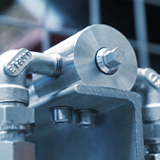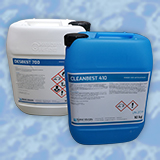The benefits of fogging and LVM
You are searching for an alternative way to apply crop protection agents in horticulture. The conventional way of spraying is labour-intensive and doesn’t always give good results. In this search you often come across the terms ‘fogging’ and ‘LVM’.
These are terms that are often used by professionals. But the meaning is often not clear. What do these terms mean and what benefits do these techniques offer?
Fogging
Fogging is a misting technique. In contrast to LVM it is also called ‘thermal fogging’. A jet engine, powered by gasoline, is used to blast a highly-concentrated crop protection agent. The liquid agent is injected into the air stream of the jet engine. The enormous amount of power and heat blasts the liquid into tiny droplets which are thrown up to 120 meters into the greenhouse. The Pulsfog K40 is the most widely used fogger in horticulture. The term ‘fogging’ is often used as a general term for many misting techniques, even on this website. This may cause confusion.
LVM
LVM means Low Volume Misting. In this technique there is no source of heat, so it is also called ‘cold fogging’. LVM machines are often powered by compressed air, like the Halofog. Some are based on turbine engines, like the Powerfogger series. There are some mentionable differences between these power sources, mainly concerning mobility of the machine, capacity and automatisation. We will return on these subjects in this article.
The differences in short:
| Fogging | LVM | |
| Mobility | ✓ | |
| Automatisation | ✓ | |
| Capacity | ✓ |
Mobility
If mobility is an important concern to you, there is no better choice than the thermal fogger range Pulsfog. All components are packed together on one cart. The liquid tanks and start battery are attached to the cart. The fuel engine is attached to the machine. This allows the cart to be moved freely and easily without the hassle of tubing or cables. The ability to move the machine through the greenhouse creates an optimal spread of fog. Better spread leads to higher preformance.
The question of automatisation
Crop protection is most often carried out around sunset. This is the ideal moment because the windows of the greenhouse have to be shut and because temperature rising must be minimised. The effectiveness of many crop protection agents is strongly reduced by UV rays. The longest possible time period without UV rays is achieved by carrying out the treatment at sunset. An additional benefit of this is that no persons are at work in the greenhouse at this time. The intake of harmful substances through the lungs or skin must be avoided at all times. This is achieved by not being present in the greenhouse, or by wearing the correct personal protection.
The above reasons are often a ground to consider the automatisation of the misting process. Automatisation is only possible with LVM machines. These are easy to program, making it possible to do treatments at the perfect time slot, without the presence of personnel. Automatisation of a thermal fogger is not possible. They are fitted with an open jet engine, and they are not safe to be left alone for extended periods of time. This means that a thermal fogger will result in after-hours work.
Capacity
One of the most important arguments for choosing between fogging and LVM is the misting capacity. Ideally, the first droplet which is fogged is still in the air at the moment the last one is expelled. This signifies a time window of about two hours. The Pulsfog K40 has a large fogging capacity and can treat 2 to 3 hectares per hour. The Check out our case of the Halofogs in a rose nursery here.
Droplet size
Up until now we mainly talked about the pros and cons of both misting techniques. The property of droplet size cannot solely be attributed to one of these techniques. Droplet sizes differ greatly between models of misting machines. Still, it is a crucial subject to discuss in this brief summary of fogging and LVM.
The droplet size is a property that is just as important as it is misunderstood. The droplet size is largely responsible for the distribution and penetration of fog in the greenhouse. Droplet size is measured by the diameter in micrometer. A smaller droplet size has less weight, and is therefore more easily transported by air currents.
The droplet size is an average size. This means half of the droplets is larger than this amount, half of it is smaller. This value says nothing about the spread within this spectrum. It is therefore important to look beyond just droplet size. Ask for a report on droplet size measurement of the machine you are interested in. The report will provide better insights in the quality of your device. We test all of our machines with our own droplet size measuring bench and we are happy to provide the test results to you.
We’ve seen multiple important factors to take into consideration when choosing the right misting machine for a specific application. Do you still have trouble deciding which method of misting is best for your situation? Please discuss your wishes with us and we will help you achieve the best fogging result.


